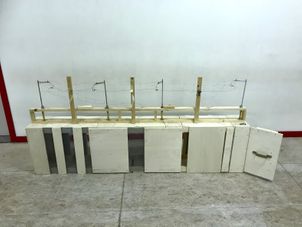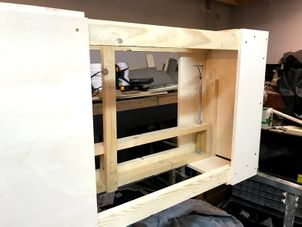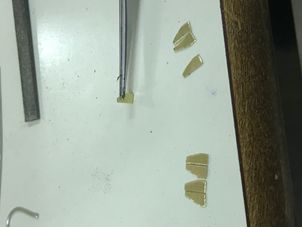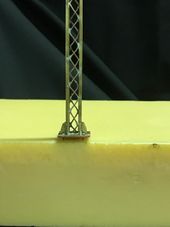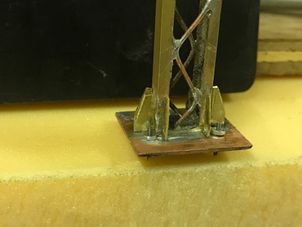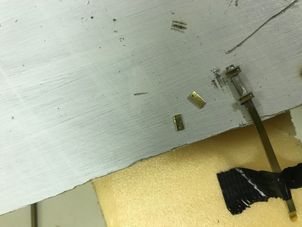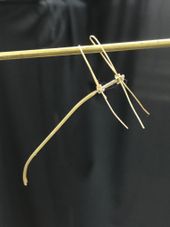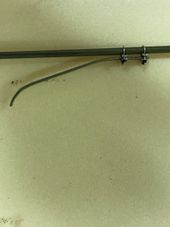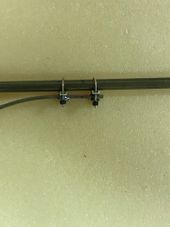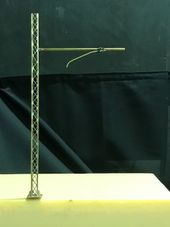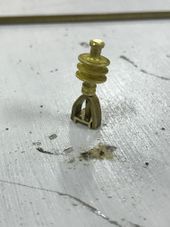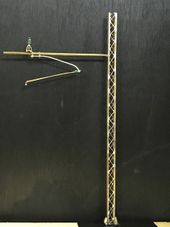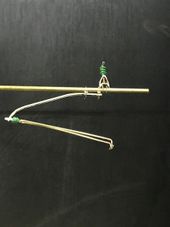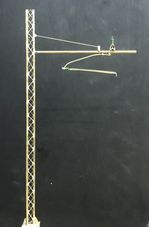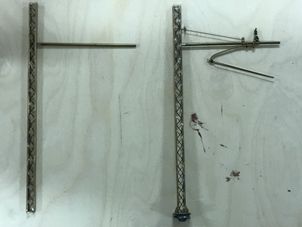Italian FS CATENARY
Construction of the Italian type FS catenary in 1/32 scale
First some pictures, then the explanation of how we make our catenary.
You can probably have more detail but we need to move our layout to exhibitions, so ... consessions have to be made.
Since we are depicting a Swiss railway, catenary is necessary. There is no compromise : it will be a contact wire in 1 piece. To make this possible both the contact wire and the suspension wire will have to be tensioned at both ends. The overhead contact line pylons are one piece with the overhead contact line and have to be detachable.
The brass tubes of K&S can be pushed together without tolerance. So the tube with the largest diameter is fixed in the landscape by means of 2-component epoxy glue. On the other tube, the catenary mast is fixed, also by fixing the mounting bolt in 2-component epoxy glue. To prevent the glue from flowing away at the bottom, I first filled the tubes half with acrylic paste or silicone paste. It is important to take quick drying glue and make sure the masts are perpendicular in all directions.
At first I thought I would make my own catenary masts (see picture) but then we got in contact with Art-and-Trains.it and the decision was quickly made. In the long run we are also going to change and use the Märklin masts a bit. The advantage of this system is that you can change catenary e.g. from SBB to DB or even to FS. Probably we will install FS masts somewhere in the future.
The wire I used is 0.3mm and 0,5mm, Phosforbronze wire from the hO-fine company. This wire is available on a roll and the vertical connections need to be soldered when the contact wire and suspension wire are tensioned between the 2 tensioning installations on the track. (These are located in the 2 technical boxes, left and right of the track.
The tensioning installations are simply 2 threaded rods on which 2 brass tubes can be shifted. On the tubes a brass plate is soldered in which a bolt is attached. On this plate the end of the thread can be hung and tensioned.
When the catenary is removed, the 4 masts must be stored somewhere together with the wire. For this purpose a holder has been made in which the pylons fit. This then slides into a transport box so that everything is well protected during transport. Here you can clearly see the brass tubes in which the pylons slide. The wire is also fastened between 2 masts to avoid loosening of the vertical suspension wires. The soldering points are also reinforced with a thin layer of 2-component epoxy glue.
In the new part of the landscape in the curve we will be standing somewhere on the border between Switzerland and Italy. In this part of Italy the catenary masts are of the Italian type. The current is still the SBB current.
We have bought again at Art&Trains.it masts. But I would also like to put the modern masts on the track. So I'm going to make the mast myself,
On Youtube I found a movie about the installation of catenary on the FS railroad. Also based on other documents I made an estimation of the dimensions in 1/32.
First a mold has to be made to bend the curved wire between the 2 mast halves.
With a drill stand I drilled holes in a wooden plank, diameter just a bit smaller than the nails I'm going to use. Then I knocked the nails into the plank and then cut them shorter so that the bent wire can be removed more easily.
The bent wire (0.8mm) needs to be soldered.
The mould has the following dimensions (once the mast is finished , it will be clear if the overall impression of the mast is good, Otherwise the dimensions have to be changed).
The bent wire makes a complete movement over 53,2 cm or +- 1,7 cm.
As distance between the 2 U-profiles (5x2mm) I took 17cm or 5,2mm.
Since the diameter of the wire is 0,8mm, the nails in the mould must be at a distance of 3,6mm.
In principle the short side of the U-profile should not be 2mm, but only 1,5mm. I used 2mm here in the first test and will see if the mast looks acceptable.
Meanwhile, we're at the end of November 2022, plans have changed a bit, in that the entire turn will be located in Switzerland. After the turn will be the small station, now with NMBS overhead lines, which will be provided with an Italian-looking station building and FS overhead lines.
Translated with www.DeepL.com/Translator (free version)
